Quick Summary:
Outsourcing Python development can be a strategic move for businesses looking to leverage this versatile programming language without building an in-house team. This guide will walk you through the key steps to effectively outsource Python development, from choosing the right outsourcing model to managing your remote team.
In this blog, we’re going to discuss 📝
- Why Python is a Top Choice for Software Development?
- What Does It Mean to Outsource Python Development?
- When Should You Outsource Python Project?
- How to Choose the right cooperation model for your Python Outsourcing Services?
- Common Pitfalls in Outsourcing Python Development
- Why Outsource Your Python Project to India?
Key Takeaways
- Outsourcing Python development offers cost-effective access to global talent, specialized skills, and quicker project timelines.
- Choosing the right outsourcing model—whether custom solutions, team extension, or dedicated teams—depends on your project’s requirements.
- Managing risks involves defining clear requirements, maintaining strong communication, and ensuring quality through regular code reviews and testing.
- Choosing the right outsourcing location can be crucial to your project success.
As you consider outsourcing Python development, it’s important to understand why Python is so highly regarded in the software industry. This insight will help you appreciate the value of choosing the right development partner and leveraging Python’s strengths. Let’s dive into what makes Python an exceptional choice for your projects.
However, if you’re decided on Python and want to find and hire Python developers that are most ideal for your project, you can skip to this section.
Why Python is a Top Choice for Software Development?
Python’s simplicity and versatility make it a top choice for various development projects, from web applications to data science and AI. With broad range of python libraries and frameworks, such as Django and Flask, it allows businesses of all sizes to build robust and scalable applications efficiently.
 Stats showcasing the demand for Python:
Stats showcasing the demand for Python:
- As per Stack Overflow Survey 2024, Python stood as the most ‘Admired and Desirable’ programming, scripting and markup languages.
- Python also ranks #1 on the TIOBE INDEX maintaining its position from August 2023 to August 2024.
- Python also ranks #3rd on the Most used programming languages among developers worldwide as of 2024 survey done by Statista.
What Does It Mean to Outsource Python Development?
Outsourcing Python development means hiring external developers or a development team to handle your Python projects rather than going through rounds of talent hunting, screening and selecting, interviewing, and onboarding in-house talents. Why is this beneficial for you?
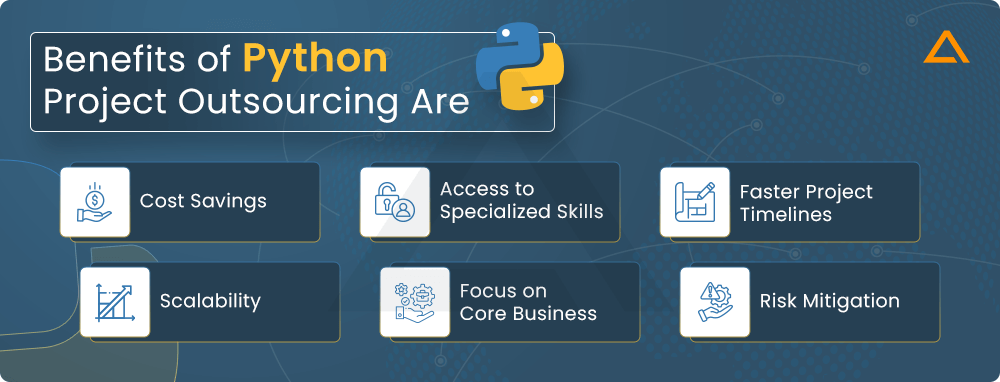
The benefits of Python project outsourcing include:
- Cost Savings: Outsourcing python projects, allows businesses to access top-notch development services at competitive rates, significantly reducing operational expenses.
- Access to Specialized Skills: Outsourcing opens the door to a global talent pool with in-depth expertise in Python frameworks like Django, Flask, and Pandas, without the need for long-term hiring commitments.
- Faster Project Timelines: With a dedicated team focused solely on your project, outsourcing enables faster development, helping you meet tight deadlines and accelerate time-to-market.
- Scalability: Outsourcing provides flexibility in scaling your team up or down based on project needs, offering dynamic resource management without the overhead of full-time staff.
- Focus on Core Business: By outsourcing technical development, your internal teams can concentrate on core business operations, strategic planning, and growth initiatives.
- Risk Mitigation: Experienced outsourcing partners can help mitigate risks associated with project delivery, ensuring that deadlines are met, and quality is maintained without burdening your internal resources.
When Should You Outsource Python Project?
Outsourcing your Python project to India or other outsourcing locations is especially beneficial when:

- Your project requires specific Python expertise that your in-house team lacks.
- You need to scale development quickly without hiring full-time employees.
- Your project has tight deadlines that require additional resources.
Outsourcing vs In-House Hiring: Python Project Cost Comparison
| Scenario | Outsourcing Benefits | In-House Team Costs |
| Specific Python Expertise Needed | Immediate Access to Experts: Avoids recruitment and training costs. | Recruitment & Training: Significant expenses and time required. |
| Need to Scale Development Quickly | Flexible Scaling: Easily adjust team size without full-time hiring costs. | Expansion Costs: High costs for hiring, onboarding, and infrastructure. |
| Tight Deadlines and Additional Resources | Faster Delivery: Quick access to resources avoids overtime and extra expenses. | Overtime & Temp Staff: Additional costs for overtime or temporary hires. |
How to Choose the Right Cooperation Model for Your Python Outsourcing Services?
Python development outsourcing can open up a number of opportunities for you, however choosing the best collaboration model can feel like daunting task. Here’s the breakdown of three popular models to help you make the right choice:
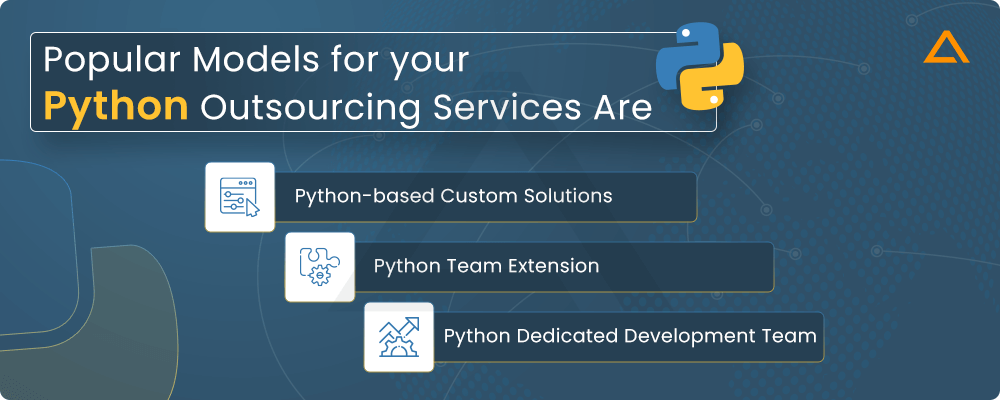
Python-based Custom Solutions
This model is ideal for the companies seeking a complete, end-to-end development, imagine a team of python experts working from scratch, collaborating with you to understand your specific needs & objective.
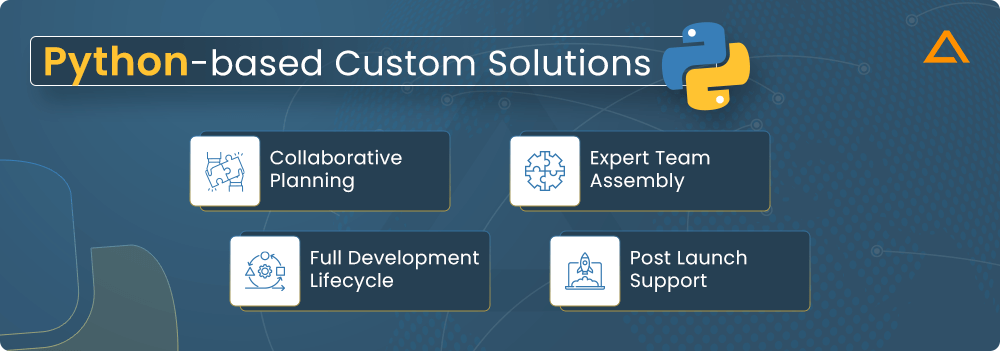
Collaborative Planning
Have in-depth discussion with the outsourcing partner to define the functionalities, timelines and more. Then create the detailed project plan with the milestones and resource allocations.
Expert Team Assembly
An entire team of python developers, project managers and QA specialists will gather and work specially on your project, ensuring the focused and dedicated effort.
Full Development Lifecycle
From basic coding and integration to intensive testing and deployment, the outsourcing partner handles it all. Regular updates and clear communication channels provide visibility throughout the process.
Post Launch Support
The Outsourced team provides the ongoing support to address any issues, updates or enhancements needed for your python support.
Python Team Extension
This model is for those who already have an in-house team but are looking to fill the gap or scale the resources.

Needs Assessments
The outsourcing partner will analyze your current team capabilities and skills and then will identify the python expertise gaps.
Targeted Recruitment
The outsourcing team will carefully select skilled python developers who will fit your technical needs but also seamlessly integrate with your company culture.
Smooth Integration
Onboarding and training help with the new python developers adapt to your project, processes and team dynamics.
Collaborative Development
The external Python experts work along with your in-house team, contributing their specialized skills to enhance overall project efficiency.
Python Dedicated Development team
This model is ideal for the long-term, complex projects that requires the deep understanding of your business. Imagine the team of python developers specially dedicated to bring your vision to life.

Dedicated Team Formation
Formation of the developer’s team, project manager, and QA Specialists. These experts are gathered around specifically for your project and are remained to be dedicated through the SDLC.
In-depth Alignment
Extensive discussions to ensure that the team thoroughly understands your business goals and project requirements.
Full Project Lifecycle Management
From initial planning & designing, to deployment & maintenance, the dedicated team takes ownership of all development related aspects.
Seamless Communication
Clear verbal exchange channels were set up for normal updates, development reviews and comments, to make sure transparency at some point of the undertaking.
Long-Term Partnership
This model tends to create long-term interactions as the team is an integral part of your development process, gaining deeper insights into your business.
Common Pitfalls in Outsourcing Python Development (and How to Avoid Them)
Outsourcing Python development offers many benefits, but it can also come with challenges if not managed properly. Here’s a detailed look at common pitfalls and how to avoid them:
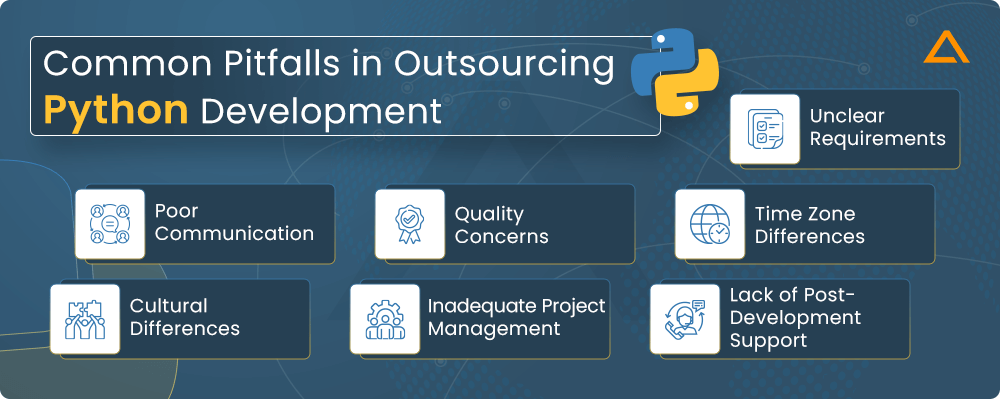
Unclear Requirements
Pitfall: One of the most common issues in outsourcing is having unclear or incomplete project requirements. This can lead to scope creep, misunderstandings, and delays.
How to Avoid It:
- Create a Detailed Project Brief: Document all aspects of the project, including functional and non-functional requirements, desired features, and technical specifications.
- Engage in Thorough Planning: Work with your outsourcing partner to define project milestones, deliverables, and timelines. Make sure there is mutual agreement on the project scope and objectives.
Poor Communication
Pitfall: Ineffective communication can result in misunderstandings, missed deadlines, and subpar outcomes. Lack of clear communication channels often exacerbates these issues.
How to Avoid It:
- Establish Clear Communication Channels: Use tools like Slack, Zoom, or Teams to facilitate regular and efficient communication.
- Schedule Regular Updates: Set up daily or weekly meetings to review progress, address issues, and provide feedback.
- Document Everything: Keep detailed records of all discussions, decisions, and changes to the project to ensure transparency and clarity.
Quality Concerns
Pitfall: Concerns about code quality and adherence to standards can arise if the outsourcing partner does not follow best practices or lacks rigorous testing.
How to Avoid It:
- Implement Regular Code Reviews: Conduct code reviews using platforms like GitHub or Bitbucket to ensure that the code meets your quality standards.
- Use Automated Testing: Employ tools like Selenium or Pytest to automate testing and catch issues early in the development process.
- Conduct User Acceptance Testing (UAT): Ensure that the final product meets your business requirements through comprehensive UAT before delivery.
Time Zone Differences
Pitfall: Working with teams in different time zones can lead to delays in communication and project progress if not managed well.
How to Avoid It:
- Align on Working Hours: Establish overlapping working hours for communication and collaboration to minimize delays.
- Use Asynchronous Communication: Leverage tools and documentation to facilitate effective communication across time zones.
Cultural Differences
Pitfall: Differences in work culture, communication styles, and expectations can create misunderstandings and affect collaboration.
How to Avoid It:
- Foster Cultural Understanding: Take time to understand your outsourcing partner’s work culture and practices.
- Set Clear Expectations: Clearly communicate your expectations regarding work quality, communication, and project management.
Inadequate Project Management
Pitfall: Poor project management practices can lead to missed deadlines, budget overruns, and project failure.
How to Avoid It:
- Adopt Agile Methodologies: Use Agile practices to manage the project iteratively, allowing for flexibility and timely adjustments.
- Define Milestones and Deadlines: Break the project into smaller tasks with clear deadlines and monitor progress regularly.
Lack of Post-Development Support
Pitfall: Failing to secure post-development support can leave you without assistance for bug fixes, updates, and maintenance after the project is completed.
How to Avoid It:
- Include Support Terms in the Contract: Ensure that your outsourcing agreement includes provisions for post-development support, including bug fixes, updates, and ongoing maintenance.
By being aware of these common pitfalls and implementing strategies to avoid them, you can enhance the effectiveness of your Python development outsourcing and achieve successful project outcomes.
Are you Looking to Hire Python Developer?
Hire a dedicated team from Aglowid for high-quality python developers who are equipped with the latest Python skill-sets
Why Outsource Your Python Project to India?
India has emerged as a leading destination for outsourcing Python development due to its vast pool of highly skilled developers, cost-effectiveness, and proven track record in delivering high-quality software solutions. Here’s why outsourcing to India is a smart choice:
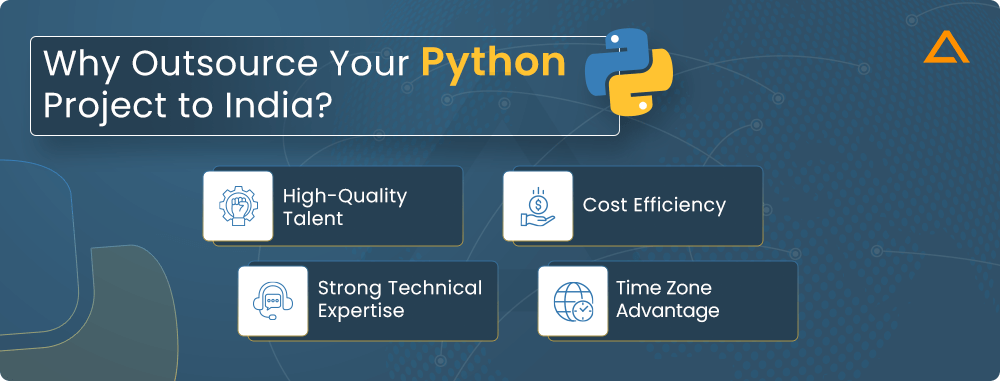
- High-Quality Talent: India boasts a large number of skilled Python developers with expertise in various frameworks and technologies.
- Cost Efficiency: Competitive rates for development services in India allow businesses to achieve significant cost savings while accessing top-tier talent.
- Strong Technical Expertise: Indian developers are well-versed in the latest technologies and methodologies, ensuring that your project benefits from cutting-edge solutions.
- Time Zone Advantage: India’s time zone can offer extended development hours, leading to faster turnaround times for your projects.
Here are some stats about the current Indian IT Outsourcing industry as per Statista–
- Revenue in the IT Outsourcing market is projected to reach US$11.04bn in 2024.
- The average Spend per Employee in the IT Outsourcing market is projected to reach US$20.25 in 2024.
- In global comparison, most revenue will be generated in the United States (US$197.30bn in 2024).
Wrapping Up!
Outsourcing Python development can streamline your project, offering cost savings, specialized expertise, and faster delivery. By selecting the right model and addressing common pitfalls like unclear requirements and poor communication, you can leverage Python’s strengths while avoiding typical outsourcing challenges.
We at Aglowid specialize in Python development with specialized profiles such as Django and Flask developers for hire. To learn more about our services or book a consultation, you can mail us at [email protected].




